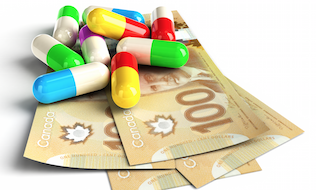
While medical advancements and drug therapy innovations have been life-changing for patients and plan members, they also come with increasing costs, said Victoria Shaw, drug benefits manager at Alberta Blue Cross, speaking at Benefits Canada’s 2019 Calgary Drug Trends Summit on Oct. 24.
Between 2011 to 2017, the number of high-cost drugs doubled. From 2016 to 2017, in particular, 31 out of 37 non-cancer-related medications that came to market cost more than $10,000 annually. “Historically, high-cost drugs were used for more rare and complex conditions, but we’re seeing a trend of them moving to treat more common conditions.”
Read: Growing use of specialty drugs putting pressure on plan sponsors: report
Looking at a private plan with around 1,000 members, Shaw said about 120 people would be receiving drug treatment for depression, 110 for asthma, 17 for migraine and one for multiple sclerosis. While there’s a range of use within these conditions, they all take up a large portion of drug spend on private plans.
Mental health is also an increasing issue and can be a leading cause of disability for employers. Referring to a new therapy marketed for treatment-resistant depression that’s currently under priority review with Health Canada, Shaw noted the drug is a fast-acting nasal spray that has to be administered every one or two weeks by a health-care professional. In the U.S., where the therapy is already available, it costs between $15,000 and $45,000 annually based on the dosage.
“It’s a higher-cost treatment than the oral antidepressant available, but it does offer a lot of hope to those patients currently suffering from depression and not getting relief.”
Read: Rising cost of drugs, benefits plans top priorities for employers: survey
When it comes to migraine treatment, CGRP2 receptor antagonist drugs are the newest options available. The injectable biologic drugs are used for prevention, said Shaw, noting two-thirds of patients on preventative migraine therapy can expect a 50 per cent reduction in headache frequency. “The cost of these drugs range from $6,400 to $7,500 annually. They’re higher cost than the current therapies available, but are offering promising results for workplace impacts by helping to reduce absenteeism and presenteeism.”
Additionally, the first oral drug for secondary progressive multiple sclerosis is on its way, she said, noting studies on the medication have shown it can reduce disease progression, which then reduces physical disability and cognitive decline. In the U.S., where it’s already marketed, the drug’s list price is more than $88,000 annually, compared to between $15,000 and $20,000 for injectable therapies.
And while Health Canada has approved two gene therapies that are indicated for certain types of cancer, they aren’t yet marketed, said Shaw, noting the cost of these types of therapies are usually quite high, ranging from $65,000 to $2 million for a single dose.
Read: New genetic therapies in cancer treatment could impact benefits plans
So where does funding fall for this type of therapy? “When it’s sitting more in the rare disease and cancer realm, is that going to fall more on government? If it moves more into the common condition realm, is that going to fall on private plans? All those things are up in the air right now.”
For private drug plans, all of these new therapies are addressing important, unmet needs in patients suffering from these conditions, noted Shaw. “But because they have higher associated costs, it’s important to have drug management strategies in place on your plan to ensure drug plan sustainability as we’re seeing more of these therapies quickly coming to market.”
Read more coverage of the 2019 Calgary Drug Trends Summit.
